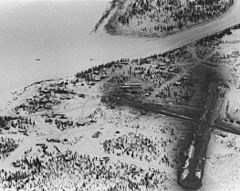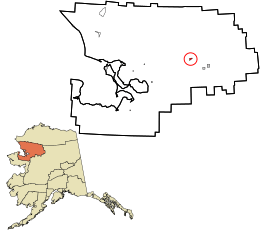Ambler, Alaska facts for kids
Quick facts for kids
Ambler
Ivisaappaat
|
|
|---|---|

Aerial Winter view of Ambler
|
|

Location in Northwest Arctic Borough and the state of Alaska.
|
|
| Country | United States |
| State | Alaska |
| Borough | Northwest Arctic |
| Incorporated | March 26, 1971 |
| Area | |
| • Total | 11.85 sq mi (30.68 km2) |
| • Land | 10.28 sq mi (26.62 km2) |
| • Water | 1.57 sq mi (4.06 km2) |
| Elevation | 79 ft (24 m) |
| Population
(2020)
|
|
| • Total | 274 |
| • Density | 26.66/sq mi (10.29/km2) |
| Time zone | UTC-9 (Alaska (AKST)) |
| • Summer (DST) | UTC-8 (AKDT) |
| ZIP code |
99786
|
| Area code | 907 |
| FIPS code | 02-01970 |
| GNIS feature ID | 1412509 |
Ambler is a small city in Northwest Arctic Borough, Alaska, United States. Its native name is Ivisaappaat in the Iñupiaq language. In 2020, about 274 people lived there.
Ambler is special because many people still speak the local Iñupiaq language. In 1999, over 91% of the community spoke it. Even young children learn the language in school. The city works closely with Kotzebue, Alaska, which is a bigger nearby town. It also has ties with the Maniilaq Health Association, which helps with health services.
Contents
Where is Ambler Located?
Ambler is found at 67°05′06″N 157°51′37″W / 67.085000°N 157.860331°W. It sits on the north bank of the Kobuk River. This is where the Ambler River meets the Kobuk River.
The city is about 45 miles north of the Arctic Circle. It is 138 miles northeast of Kotzebue. Ambler is also 30 miles northwest of Kobuk. It is 30 miles downriver from Shungnak.
The United States Census Bureau says Ambler covers about 11.85 square miles (30.68 square kilometers). Most of this area is land, with a small part being water.
What is Ambler's Climate Like?
Ambler has a subarctic climate. This means it has very long and cold winters. Its summers are short and warm. Winter temperatures often drop below -40°F (-40°C).
Even in winter, temperatures can sometimes rise above 10°F (-12°C). This happens because Ambler is somewhat close to the Pacific Ocean. It can even get above freezing in January, but this is rare. Ambler also gets more rain and snow than places further east in Alaska.
Summers in Ambler can vary a lot. Some days are warm, and others are cooler. The highest temperature in a year is usually around 80°F (26°C). It can sometimes go above 86°F (30°C). For example, in June 2013, it reached 90°F (32°C) on two days.
The Kobuk River is open for boats from early June to mid-October.
Ambler Weather Details
Below is a table showing weather information for Ambler from 1981 to 1992:
| Climate data for Ambler West, Alaska | |||||||||||||
|---|---|---|---|---|---|---|---|---|---|---|---|---|---|
| Month | Jan | Feb | Mar | Apr | May | Jun | Jul | Aug | Sep | Oct | Nov | Dec | Year |
| Record high °F (°C) | 37 (3) |
38 (3) |
40 (4) |
53 (12) |
85 (29) |
93 (34) |
92 (33) |
85 (29) |
75 (24) |
46 (8) |
39 (4) |
35 (2) |
93 (34) |
| Mean daily maximum °F (°C) | −0.7 (−18.2) |
0.8 (−17.3) |
14.1 (−9.9) |
25.3 (−3.7) |
50.7 (10.4) |
69.4 (20.8) |
71.1 (21.7) |
62.0 (16.7) |
49.2 (9.6) |
26.8 (−2.9) |
7.4 (−13.7) |
6.6 (−14.1) |
31.9 (−0.1) |
| Daily mean °F (°C) | −9.3 (−22.9) |
−9.4 (−23.0) |
2.1 (−16.6) |
13.5 (−10.3) |
40.2 (4.6) |
56.3 (13.5) |
59.3 (15.2) |
52.1 (11.2) |
40.7 (4.8) |
19.7 (−6.8) |
0.1 (−17.7) |
−1.7 (−18.7) |
22.0 (−5.6) |
| Mean daily minimum °F (°C) | −17.9 (−27.7) |
−19.6 (−28.7) |
−10 (−23) |
1.8 (−16.8) |
29.7 (−1.3) |
43.3 (6.3) |
47.6 (8.7) |
42.2 (5.7) |
32.1 (0.1) |
12.5 (−10.8) |
−7.3 (−21.8) |
−9.9 (−23.3) |
12.0 (−11.0) |
| Record low °F (°C) | −74 (−59) |
−65 (−54) |
−54 (−48) |
−38 (−39) |
−12 (−24) |
25 (−4) |
32 (0) |
25 (−4) |
6 (−14) |
−23 (−31) |
−49 (−45) |
−58 (−50) |
−74 (−59) |
| Average precipitation inches (mm) | 1.15 (29) |
1.13 (29) |
0.92 (23) |
1.59 (40) |
1.48 (38) |
1.33 (34) |
2.66 (68) |
4.50 (114) |
4.35 (110) |
1.72 (44) |
0.55 (14) |
1.67 (42) |
23.05 (585) |
| Average snowfall inches (cm) | 19.7 (50) |
16.7 (42) |
17.6 (45) |
17.2 (44) |
4.1 (10) |
0 (0) |
0 (0) |
0 (0) |
3.7 (9.4) |
17.9 (45) |
9.6 (24) |
27.5 (70) |
134 (339.4) |
The History of Ambler
The community of Ambler is named after a river. That river was named for Dr. James M. Ambler. He sadly died in 1881 when his ship got stuck in Arctic ice.
People first settled permanently in Ambler in 1958. They moved from nearby towns like Shungnak and Kobuk. They chose Ambler because it had many fish, wild animals, and spruce trees. An old archaeological site called Onion Portage is also nearby.
Ambler got its first post office in 1963. Sarah Tickett was the first Post Master. The city officially became a city in 1971.
An old story tells of a prophet named Maniilaq. He predicted that a great whale would one day swim upriver to Ambler. Some of the founding fathers of Ambler were Harry Tickett, Truman Cleveland, and Nelson Greist Sr.
How People Travel in Ambler
The main ways to get around Ambler are by plane, small boat, and snowmachine. There are no roads that connect Ambler to other parts of Alaska.
Ambler Airport is located about one and a half miles from the city. It has a gravel airstrip that is 3,000 feet long. Several airlines offer flights, including Bering Air and Hageland Aviation. Air taxis also provide special charter flights. The airport has been improved a lot in recent years.
People use boats to travel between villages and for hunting and fishing. In winter, ATVs (all-terrain vehicles) and snowmachines are very common. There are plans to build a 211-mile road from the Dalton Highway to the Ambler area. This road would help with future mining projects.
Ambler's Economy and Jobs
Jobs in Ambler are mostly found at the school, the city government, the local clinic, and stores. Some mining also happens in the area. A few residents have permits for commercial fishing.
A big part of the local economy is subsistence. This means people get their food directly from nature. Chum salmon and caribou are the most important food sources. People also hunt moose and bear, and gather berries.
Local artists make and sell beautiful items. These include birch baskets, fur pelts, and carvings made from jade, quartz, bone, and ivory. These items are sold in gift shops across Alaska. The community is interested in building a place where local artists can work with stones. There are also plans to start more mining in the region because of large mineral deposits.
Ambler's Population
| Historical population | |||
|---|---|---|---|
| Census | Pop. | %± | |
| 1960 | 70 | — | |
| 1970 | 169 | 141.4% | |
| 1980 | 192 | 13.6% | |
| 1990 | 311 | 62.0% | |
| 2000 | 309 | −0.6% | |
| 2010 | 258 | −16.5% | |
| 2020 | 274 | 6.2% | |
| U.S. Decennial Census | |||
Ambler first appeared in the U.S. Census in 1960. It officially became a city in 1971.
In 2000, there were 309 people living in Ambler. Most of the people were Native American (84.79%). About 12.94% were White.
Many households in Ambler have children. In 2000, 54.4% of households had children under 18. The average household had about 3.91 people. The average family had about 4.33 people.
The median age in Ambler was 22 years old. This means half the people were younger than 22, and half were older. About 41.7% of the population was under 18 years old.
The median income for a household in 2000 was $43,500. This means half the households earned more than this, and half earned less. About 14.3% of the population lived below the poverty line.
Education in Ambler
The Northwest Arctic Borough School District operates the Ambler School. In 2017, the school had 7 teachers and 69 students. About 94% of the students were Alaska Natives.
See also
 In Spanish: Ambler (Alaska) para niños
In Spanish: Ambler (Alaska) para niños

